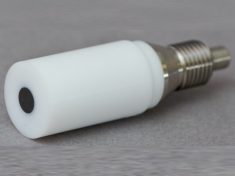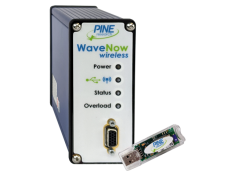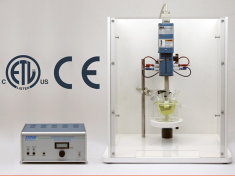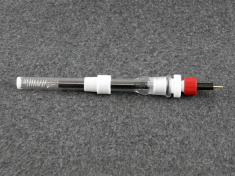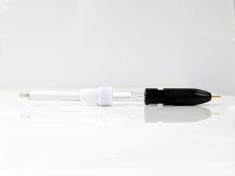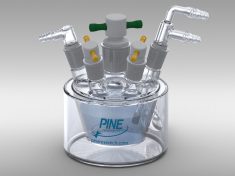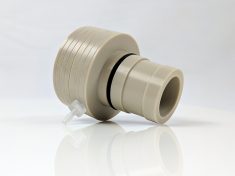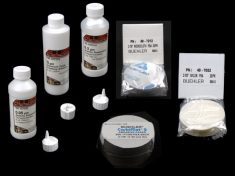| # | Description | Price in USD | |
|---|---|---|---|
| Potentiostat/Rotating Disk Electrode (RDE) Bundle | |||
| [WNW-MSR-RDE-E5] |
MSR Rotator Rotating Disk Electrode with WaveNow Wireless Bundle includes potentiostat, MSR Rotator, software, cables, electrodes, cell, and accessories |
||
| Power Cords |
this bundle includes two power cords |
||
| List of All Items Included in Bundle | |||
| AfterMath |
Pine Research AfterMath Software |
||
| AFTP4 |
WaveNow Wireless Potentiostat/Galvanostat |
||
| AFMSRCE |
Pine Research MSR Electrode Rotator the most popular electrode rotator in the world |
||
| AFE6MB |
RDE/RRDE Shaft for MSR Rotators |
||
| RRTPE40-T |
Shielded WaveNow Cell Cable cable assembly with outer shield; HD-15 male to five banana plugs with optional alligator clips |
||
| RRTPE50-T |
MSR Rotator Rate Control Cable |
||
| AFE5T050GC |
Glassy Carbon RDE Tip disk material is not removable from RDE tip maximum rotation rate is 2500 RPM - never exceed maximum rotation rate when working with rotating electrodes. |
||
| AFCTR5 |
Standard Platinum Counter Electrode Kit |
||
| RREF0021 |
Single-Junction Silver Chloride (Ag/AgCl) Reference Electrode |
||
| AKCELL3 |
Jacketed Glass Cell for Rotating Electrodes |
||
| AC01TPA6M |
Gas-Purged Bearing Assembly |
||
| AKPOLISH |
Polishing Solutions and Materials Kit |
||
This bundle pairs a WaveNow® Wireless potentiostat with a Pine Research Modulated Speed Rotator (MSR) – the most popular electrode rotator in the world. The bundle features a fixed-disk glassy carbon Rotating Disk Electrode (RDE) tip, along with an electrochemical cell, reference and counter electrodes, and related accessories.
Under the control of our powerful AfterMath® software package, the WaveNow Wireless Potentiostat/Galvanostat is capable of performing a wide range of DC electroanalytical techniques including several RDE methods. This potentiostat plays well with the Pine Research MSR Rotator and is able to automatically control the rotation rate while measuring electrochemical signals. This RDE start-up bundle includes the following principal items along with compatible cables and accessories:
- WaveNow Wireless Potentiostat/Galvanostat
- Pine Research MSR Rotator with Fixed-Disk Glassy Carbon RDE tip
- Pine Research AfterMath Software
- Jacketed RDE Cell (glass) with Pt Counter and Ag/AgCl Reference Electrode
This bundle combines the Pine Research MSR Rotator (the most popular electrode rotator in the world) with a WaveNow Wireless Potentiostat. The bundle includes a selection of the most popular accessories for rotating disk voltammetry, including a five-neck and water-jacketed electrochemical cell, a glassy carbon RDE (the working electrode), a platinum counter electrode, and a silver/silver-chloride reference electrode. A special rotation rate control cable allows the potentiostat to directly control the rotation rate, so that you can set up all of your experimental parameters, including the rotation rate, using our powerful AfterMath instrument control and data analysis software.
The WaveNow Wireless Potentiostat/Galvanostat is the latest development in our popular WaveNow® compact potentiostat series. How do you make something great even better? Reduce the wire clutter! For years, our customers have enjoyed using our small yet powerful WaveNow potentiostats for educational, research, and field-based applications. Now, the engineering team at Pine Research has stepped it up a level, adding wireless communication plus a few other new features. Imagine setting up your glovebox with an electrochemical experiment and not having to worry about passing cell cables or communications cables through the wall of the glovebox. The WaveNow Wireless makes this possible today.
This full-featured DC potentiostat includes six current ranges, a wide ± 8.0 V potential range, built-in iR compensation, an overload LED indicator, and an external port allowing it to control a rotating electrode or a spectrometer. Communication between the computer and the potentiostat can occur via a direct USB connection or via a wireless USB dongle. Power to the potentiostat can be supplied from a traditional AC power supply or from a rechargeable DC battery.
A license for our AfterMath® instrument control and data analysis software is included with every system. This single license gives you access to all of the DC electrochemical methods that the WaveNow Wireless can perform (Pine Research does not charge you extra for various categories of electrochemical techniques – will give all of them to you with a single license). Key features of our AfterMath software are listed below:
- Instrument Control. When started, AfterMath automatically detects all compatible instrumentation attached to the computer and provides complete control over each instrument. AfterMath can simultaneously and independently control multiple instruments, and multiple experiments may be queued on each individual instrument. Even as new experiments are queued or running in the background, data acquired in previous experiments may be manipulated by the user.
- Flexible Plotting. AfterMath has a powerful “drag-n-drop” feature that allows traces from one plot to be quickly and easily copied and moved to other plots. Preparing an overlay plot from several voltammograms is straightforward. AfterMath provides precise control over line sizes, point markers, colors, axis limits, axis labels, and tick marks. One or more text boxes may be placed anywhere on a plot, and the text may be formatted with any combination of fonts, font sizes, or colors as desired.
- Scientific Units. Unlike graphing software designed for business and marketing applications, AfterMath is designed with scientific data in mind. Proper management of scientific units, metric prefixes, scientific notation, and significant figures are built into Aftermath. For example, if an operation divides a potential measured in millivolts by a current measured in nanoamperes, then Aftermath properly provides the result as a resistance measured in megaohms.
- Data Archiving. A unique and open XML-based file format allows data from several related experiments to be stored together in one single archive file. Keeping related experiments together in an archive file eliminates the need to manage multiple individual data files on the hard drive. The internal archive hierarchy can contain as many subfolders, reports, plots, notes, experimental parameters, and data sets as desired (subject to available memory and storage).
- Tools and Transforms. Flexible tools can be placed on any graph to precisely measure quantities such as peak height and peak area. Multiple tools can be placed on a plot, and all such tools remain exactly where they are placed, even if the data archive is saved to a disk and reloaded at a later time. Fundamental mathematical operations (addition, multiplication, integration, logarithm, etc.) can be applied to any trace on any plot.
If you are already an owner of an earlier WaveNow model, you may be wondering how the WaveNow Wireless differs from earlier models. Our engineering team has packed the following new features into the WaveNow Wireless:
- iR Compensation. If you are working in a highly resistive solvent system, you can measure the uncompensated resistance between the working and reference electrodes (using a positive feedback iR drop measurement), and then the potentiostat can actively correct for this iR drop in subsequent voltammetry experiments.
- Overload Indicator Light. A red indicator light on the front panel signals an overload condition (i.e., signal exceeds measurement range).
- Wireless Communication. Communication is now possible without having to route a USB cable to the instrument.
- Expanded Current Ranges. Improved low current and high current limits with six ranges from ±5 nA to ±150 mA.
- Potentiostat Housing. The original WaveNow features a slick enclosure, but forces its use in one plane. Now, the (slightly larger) housing for the WaveNow Wireless permits either vertical or horizontal orientation for easier installation in tight spaces.
MAXIMUM ROTATION RATE: Each electrode tip model used with the Pine Research MSR Rotator has a maximum rotation rate. Do not the exceed maximum rotation rate when working with rotating electrodes.
The Pine Research MSR Rotator is the most popular rotating electrode configuration worldwide. This flexible electrochemical instrument may be used with Rotating Disk Electrodes (RDE), Rotating Ring-Disk Electrodes (RRDE), and Rotating Cylinder Electrodes (RCE). The MSR Rotator bears both the CE and ETL marks and is compatible with most international power configuration standards.
The rotation rate of the electrode may be adjusted using a control knob on the front panel of the motor control unit, or alternately, the rotation rate can be controlled via an analog control signal provided by a potentiostat or by a third-party waveform generator. The rotation rate may be viewed using the LCD display on the front panel. The rotation rate is adjustable over a range from 50 to 10,000 RPM and is accurate to within 1% of the reading on the display. A rotation rate may also be monitored via an output signal proportional to the rotation rate which is available on the front panel.
The rotation rate may be controlled and modulated by a sine wave, square wave, or other externally generated waveform. The outstanding acceleration characteristics of the motor and its control circuitry allow the rotation rate to follow the control waveform with very little error. This feature is particularly desirable for techniques such as Hydrodynamic Modulation Voltammetry (HMV).
The rotator motor position is easily raised or lowered with respect to the cell platform, making immersion or removal of the rotating electrode tip quick and easy. The enclosure base is made from chemically resistant polypropylene, and the large enclosure window provides a good view of rotating electrode during operation. (A smaller base is available separately for using the rotator in a glove box or fume hood.)
This bundle is a good choice for an initial laboratory setup. As your research evolves, it is likely your specific needs will change. Pine Research has you covered, and we offer many additional kinds of rotating electrode tips and accessories to allow you to expand the capabilities of your MSR Rotator. This rotator can also be used with Rotating Ring-Disk Electrodes (RRDE). If you are contemplating future RRDE research work, keep in mind that working with an RRDE requires a bipotentiostat, and we suggest that you consider our WaveDriver 40 DC Bipotentiostat or our WaveDriver 200 EIS Bipotentiostat to control such RRDE experiments.
Visit our YouTube channel for helpful instructional videos regarding the use and maintenance of this and many other Pine Research products.
All specifications are subject to change without notice.
| WaveNow Wireless Potentiostat | |
|
Working Electrode Channels |
1 |
|
Measured Current Ranges |
±150 mA, ±5 mA, ±150 μA, ±5 μA, ±150 nA, ±5 nA |
|
Autoranging |
Yes |
|
Practical Current Range |
1 pA to 150 mA |
|
ADC Input |
16 bits |
|
Compliance Voltage |
> ±11 V |
|
Measured Potential Ranges |
±8.0 V |
|
CV Sweep Rate (min) |
10 μV/s (469 μV step per 46.9 s, 313 μV step per 31.3 s, or 78 μV per 7.8 s) |
|
CV Sweep Rate (max) |
10 V/sec (10 mV step every 1.0 ms) |
|
Point Interval |
1 ms (minimum) |
|
EIS Capable |
No |
|
EIS Frequency Range |
N/A |
|
Instrument Dimensions |
55 × 170 × 130 mm (2.17 × 6.69 × 5.12 in) |
|
Instrument Weight |
0.6 kg (1.25 lb) |
|
Interface |
Wireless or USB |
|
Wireless Capable |
Yes |
Additional Specifications |
|
| Modulated Speed Rotator (MSR) | |
|
Rate Accuracy |
100 to 200 RPM: Accurate to within ±2 counts of display reading |
|
Rate Control (external) |
Optional rate control via input signal on control unit front panel |
|
Rate Output |
Allows optional external monitoring of rotation rate (banana jack, control unit front panel) |
|
Maximum Continuous Torque |
28.3 mN m |
|
Motor Power |
15 W |
|
Electrode Connections |
Disk electrode: red banana jack on motor unit |
|
Dimensions |
Control unit: 11.4 × 10.1 × 5.75 in (29 × 26 × 15 cm) |
|
Shipping Information |
Shipping weight: 60 lb (27 kg) |
|
Rotating Disk (RDE) |
E2, E3, E4TQ, E5, E5TQ |
|
Rotating Ring-Disk (RRDE) |
E6, E7, E8 |
|
Rotating Cylinder (RCE) |
ACQC, E9 |
Additional Specifications |
|
| Single Junction Silver Chloride Reference Electrode | |
|
Standard Potential |
0.199 V vs. NHE |
|
Filling Solution |
4 M KCl with AgCl |
| Document # | Title |
|---|---|
| WaveNowXV Potentiostat/Galvanostat | |
|
DRU10249 |
WaveNow Wireless Potentiostat/Galvanostat User Guide |
| Pine Research MSR Rotator | |
|
DRU10002 |
Pine Research MSR Rotator User Guide |
|
DRB10087 |
Pine Research MSR Rotator Marketing Brochure |
| Electrode Information | |
|
DRP10045 |
E5 Series RDE Tip Information |
|
DRP10061 |
Care and Use of the Platinum Counter Electrode Kit |
|
DRP10025 |
Silver/Silver-Chloride Reference Electrode User Guide |
|
DRK10135 |
Electrode Shrouds Overview |
|
DRK10013 |
Pine Research Electrode Polishing Guide |
Contact us with any questions or support requests by phone or e-mail.
Below are selected product references:





